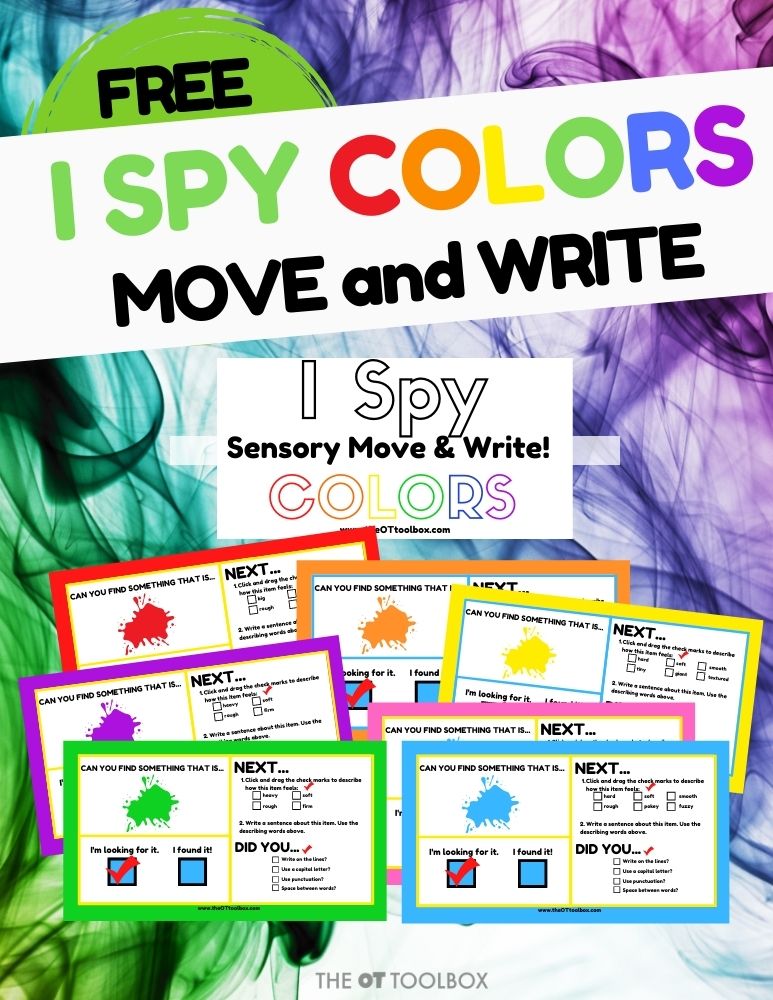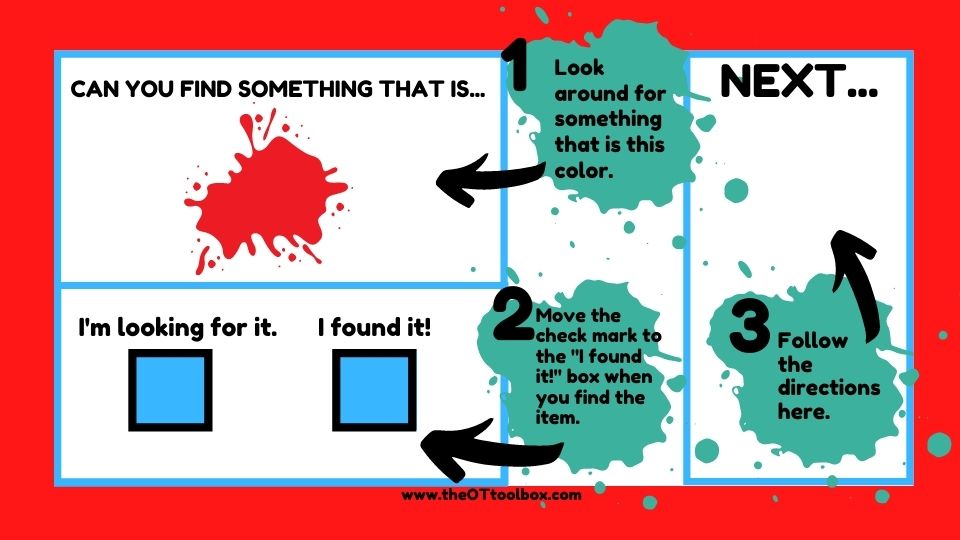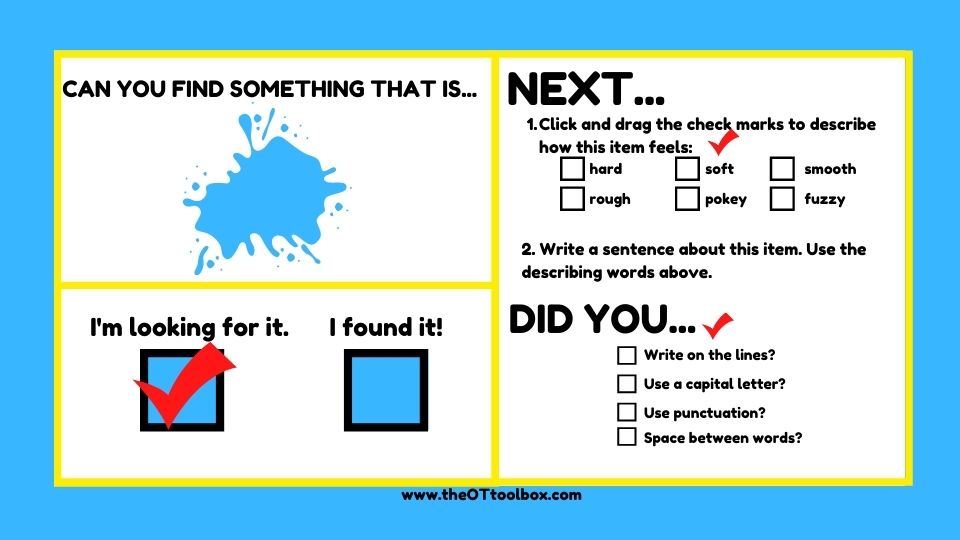If you’ve ever played “I Spy with my Little Eye”, then you are going to love this I Spy colors therapy slide deck. It’s a movement activity that gets kids up and moving and challenges several developmental skill areas: visual processing, tactile sensory exploration, handwriting, and strength, endurance, and movement challenges. Kids can go through the free therapy slide deck in an occupational therapy teletherapy session and work on learning colors as well. Add I Spy colors as a color scavenger hunt that kids will love!
Use this along with our color exercises slide deck for more color theme activities in therapy.
This I Spy virtual game is just one of the free slide decks we have available here on the site. You’ll also love our printable color by letter worksheet. Check them all out!

Need more teletherapy resources? Working with kids in teletherapy? Need streamlined info on how to structure your sessions? Need activities for week-to-week therapy planning? need answers for all of your teletherapy questions? Join the free teletherapy course, a 5 day email series on telehealth for occupational therapists.
I Spy Colors
The kids you are working with may have played I Spy before. In a traditional look-and-find game, they need to search a book, puzzle page, or other activity page for hidden items. You may have even played I Spy with my little eye while waiting at a doctor’s office, or in a restaurant. It’s a good activity for kids that keeps them busy. But did you know there are even more therapeutic benefits to this game?
I wanted to create a teletherapy activity that required no materials other than paper and pencil. This I Spy Colors therapy slide deck does the trick.
Therapists can use this free interactive slide deck in therapy treatment sessions virtually as a color scavenger hunt activity.
The activity asks users to search their house for an object of a particular color. By looking around the home for the color detail of objects, children are strengthening several visual perceptual skill areas:
- Visual scanning– moving the eyes for a specific aspect of details: colors of objects. Visual scanning is a skill needed for reading as kids scan their eyes over the lines of a page.
- Visual discrimination– visually determining differences in colors of objects. The slides ask kids to locate items that are in a range of colors. This color activity is slightly more advanced than just finding a blue item. Can they find teal? Visual discrimination is a skill needed for distinguishing differences in letters and words when reading.
- Figure-ground– Pulling out details of objects from a busy background. When users scan their home for a specific color, they are visually identifying objects that may be hidden in a busy background. This visual skill is used in functional tasks every day.
- Visual memory– Holding a “picture” of details such as the shade of color in the mind. As kids look throughout their room or home, visual memory is needed to recall the color and shade they are looking for. This visual skill is needed in reading and math.
- Visual closure– identifying an object when only parts of it are seen. This visual perceptual skill is used when children locate an object in the room that may be partially hidden. Visual closure is used in reading when readers are able to identify a word by only some of the letters.
- Visual convergence– A visual processing skill, this motor task allows vision to shift in scanning. By scanning to near and far points, kids are strengthening this skill. Visual convergence is used in the classroom when scanning from a teacher or the board to the desk, or from near to far and far to near.
Users can then identify features of the object by responding to questions about texture. The slide deck asks about aspects of the found item by asking the child to explore the tactile aspect. Is the item fuzzy? Soft? Rough? How does it feel?
This part of the color activity brings in features of the tactile sensory system.

Virtual I Spy
This virtual I Spy activity takes the fun of the classic look and find game online, making it great for teletherapy activities with kids of all ages. This particular color game goes beyond just “I Spy” however…
Use the virtual activity for working on other areas in therapy, too:
- Movement challenges- Kids get up and move to find the objects
- Visual perceptual skills- covered above
- Tactile sensory exploration and challenges- Can they find a green object that is fuzzy? This activity can be expanded in many ways!
- Handwriting- work on skills such as line awareness, letter formation, sizing, legibility. Kids can then self-assess their work, making carryover of writing skills stick.
Users can move the interactive piece of the slide deck to mark off tactile sensory aspects of the colorful item they found.
Finally, there is a color writing activity where users can write a sentence about the object, using the describing words that they selected. This part of the slide deck may be a higher level for some users, but the writing piece invites users to incorporate aspects of language and creative writing into the I Spy Colors activity.

I Spy Colors for all ages
The slide deck is designed so it meets various levels and can be graded to different ages:
- Younger kids can just look for the objects in a color scavenger hunt.
- Teach colors, making it a preschool color activity that is perfect for virtual learning.
- Some children can skip the tactile sensory aspect and just seek out items in the I Spy portion of the activity.
- Grade the activity up by discussing tactile features.
- Further grade the activity up by incorporating handwriting. Younger students can just write the word.
- Older students can write the word in a sentence, working on adding describing words.
- Kids that complete the handwriting portion of the slide deck activity can self-assess their handwriting, using the interactive check marks as they look over their written work.
There’s somethign for everyone with this I Spy Colors therapy activity!
Want to play I Spy Colors?
Grab the free Google slide deck by entering your email into the form below. You will receive a PDF containing a link to open the slide deck. Be sure you are logged into your Google account before clicking the button on that PDF. Save the PDF in your therapy files so you can access this resource any time and share with those on your caseload.
More color activities
Add this slide deck to these hands-on color activities:
Benefits of coloring– Use a couple of crayons to work on many areas of child development.
Visual Motor Color Match Activity– This activity translates wonderfully to virtual therapy sessions. It can be used in face-to-face interventions as well, or as a home activity.
Colored Pencils Handwriting Activities– All you need is a set of colored pencils for working on many skill areas.
Color Mixing Rainbow Write– Work on letter formation and size with this rainbow write activity that challenges kids to mix colors and see what the result is.

Colleen Beck, OTR/L has been an occupational therapist since 2000, working in school-based, hand therapy, outpatient peds, EI, and SNF. Colleen created The OT Toolbox to inspire therapists, teachers, and parents with easy and fun tools to help children thrive. Read her story about going from an OT making $3/hour (after paying for kids’ childcare) to a full-time OT resource creator for millions of readers. Want to collaborate? Send an email to contact@theottoolbox.com.






